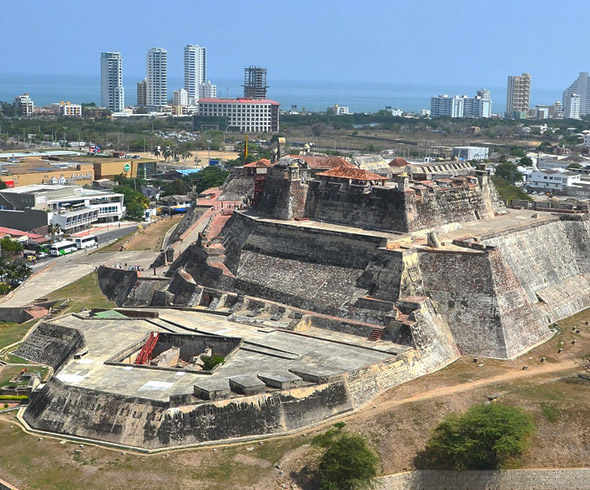menu
-
MenuBack
-
 Menu
Menu
The San Felipe de Barajas Castle is one of the most emblematic monuments of Cartagena de Indias, Colombia. This impressive fortress, located on the San Lázaro hill, stands as a testimony to the city's rich colonial and military history. Over the centuries, the castle has been a symbol of resistance and strength, defending the city from invasions and attacks. This article will explore the history of Castillo San Felipe de Barajas, from its construction to its role in the defense of Cartagena, and its legacy as historical and cultural heritage.
The construction of the San Felipe de Barajas Castle began in 1536, under the direction of the Spanish military engineer Antonio de Arévalo. Its strategic location on the San Lázaro hill offered a panoramic view of the city and the bay, which made it an ideal point for defense against possible invaders. The fortress was designed to resist attacks from both sea and land, with thick walls, bastions and cannon batteries.
The original castle was relatively small, but over the years, it was expanded and strengthened in response to increasing threats from pirates and privateers. In 1657, during the government of Viceroy Pedro Zapata de Mendoza, important improvements and expansions were made, which included the construction of new bastions and the addition of tunnels and underground galleries to facilitate the movement of troops and supplies.
The San Felipe de Barajas Castle played a crucial role in the defense of Cartagena de Indias during several attacks and invasions. One of the most notable episodes occurred in 1741, when the city was attacked by a powerful British fleet under the command of Admiral Edward Vernon. This siege, known as the Battle of Cartagena de Indias, was one of the most significant confrontations of the 18th century in the Caribbean.
The British fleet, consisting of 186 ships and more than 27,000 men, attempted to take the city as part of the War of the Seat. However, the defense of Cartagena was led by the Spanish commander Blas de Lezo, a veteran marine known for his bravery and cunning mind. Despite being at a numerical and resource disadvantage, the Spanish forces and the city's defenders, with the crucial support of Castillo San Felipe, managed to repel the British attack. The victory in this battle was a testament to the strategic importance and solidity of the fortress.

The San Felipe de Barajas Castle is an outstanding example of Spanish colonial military architecture. Its design is characterized by a series of zigzag walls, which offered effective defense against artillery fire. The outer walls are interconnected with bastions and batteries that allowed for defense in depth, ensuring that even if an invader managed to overcome one line of defense, they would immediately face another.
The castle also has a network of underground tunnels, used to safely transport ammunition, supplies and troops. These tunnels, some of which are open to the public today, are an example of the ingenious military engineering of the time. In addition, the fortress had several parade grounds, gunpowder stores and quarters for troops, making it self-sufficient during long periods of siege.

Over the centuries, Castillo San Felipe de Barajas has undergone several restorations and conservation efforts. In the 20th century, the Colombian government and various international organizations recognized the historical and cultural importance of the fortress and undertook restoration projects to preserve its structure and open it to the public as a tourist site.
In 1984, the San Felipe de Barajas Castle, together with the historic center of Cartagena de Indias, was declared a World Heritage Site by UNESCO. This designation underlines the importance of the castle not only as a key piece of Colombia's military history, but also as a symbol of the resistance and strength of the Cartagena people.
Today, the San Felipe de Barajas Castle is one of the main tourist attractions in Cartagena de Indias. Thousands of visitors from all over the world come each year to explore its tunnels, walk along its walls and enjoy the panoramic views of the city and the bay. The castle not only offers a window to the past, but is also a place where cultural events, exhibitions and educational activities are held, keeping Cartagena's rich history alive.
The San Felipe de Barajas Castle is much more than a fortress; It is a symbol of the resilience and bravery of the people of Cartagena de Indias. Over the centuries, it has resisted numerous attacks and has witnessed important episodes in the colonial history of the Caribbean. Its impressive architecture and ingenious design are a testament to the knowledge and skill of the Spanish military engineers of the time. Today, the castle remains a vibrant monument and reminder of Cartagena's historical legacy, attracting visitors and reminding us of the importance of preserving our cultural heritage for future generations.
Leave a comment